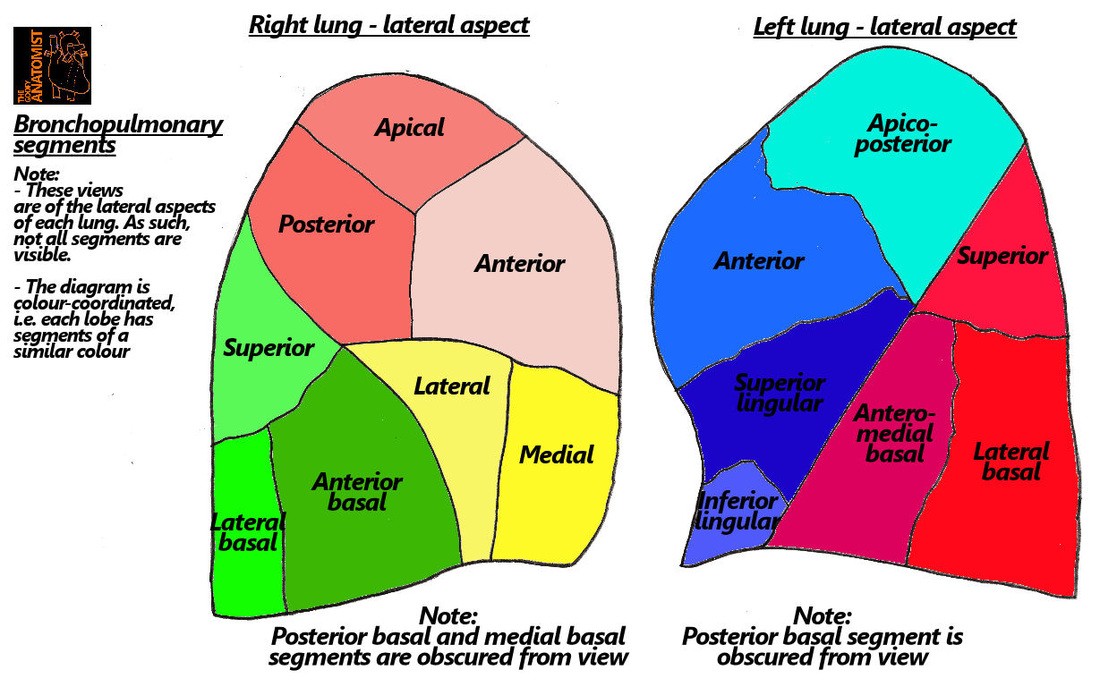Bronchi
Definition
A tube for the passage of air into the lungs
Part of Respiratory System
Continuation of the trachea
Trachea divides into two at the leverl of T5 (sternal angle) and forms two main or primary bronchi one for the right lung and one for the left.
No gas exchange takes place in the bronchi.
Structure
The point where the trachea divides into two is called the carina
The bronchi branch into smaller secondary and tertiary bronchi; the secondary bronchi also known as lobar bronchi; the tertiary bronchi are known as segmental bronchi, each supplying a bronchopulmonary segment
A bronchopulmonary segment is a division of a lung separated from the rest of the lung by a septum of connective tissue (segmentectomy made possible)
Tertiary bronchi further branch into smaller tubes known as bronchioles
which divide into terminal bronchioles,
each of which then gives rise to several respiratory bronchioles,
which go on to divide into two to eleven alveolar ducts.
There are five or six alveolar sacs associated with each alveolar duct.
The alveolus is the basic anatomical unit of gas exchange in the lung.
The main bronchi are lined by respiratory epithelium.
This cellular lining has cilia which removes dust and other small particles.
There is a smooth muscle layer below the epithelium
This smooth muscle layer contains seromucous glands
Hyaline cartilage is present in the bronchi, surrounding the smooth muscle layer.
In the main bronchi, hyaline cartilage forms an incomplete ring
in the smaller bronchi, hyaline cartilage is present in irregularly arranged plates and islands.
These plates give structural support to the bronchi and keep the airway open.
As branching continues through the bronchial tree, the amount of hyaline cartilage in the walls decreases until it is absent in the bronchioles.
As the cartilage decreases, the amount of smooth muscle increases.
The mucous membrane also undergoes a transition from ciliated pseudostratified columnar epithelium to simple cuboidal epithelium and to simple squamous epithelium.
Right main bronchus
Wider, shorter and more vertical than the left
It divides into three secondary bronchi and delivers oxygen to the three lobes of the right lun - the superior, middle and inferior lobe.
The right main bronchus is closely related to the azygos vein and the right pulmonary artery
Left main bronchus
Smaller in caliber but longer than the right,
It passes beneath the aortic arch,
crosses in front of the esophagus, the thoracic duct, and the descending aorta,
It has the left pulmonary artery lying at first above, and then in front of it.
The left main bronchus divides into two secondary or lobar bronchi to deliver air to the two lobes of the left lung—the superior and the inferior lobe.
Bronchopulmonary Segements
Right lung
Superior lobe
apical segment
posterior segment
anterior segment
Middle lobe
lateral segment
medial segment
Inferior lobe
superior segment
medial-basal segment
anterior-basal segment
lateral-basal segment
posterior-basal segment
Left lung
Superior lobe
apico-posterior segment(merger of "apical" and "posterior")
anterior segment
Lingula of superior lobe
inferior lingular segment
superior lingular segment
Inferior lobe
superior segment
anteromedial basal segment (merger of "anterior basal" and "medial basal")
posterior basal segment
lateral basal segment






